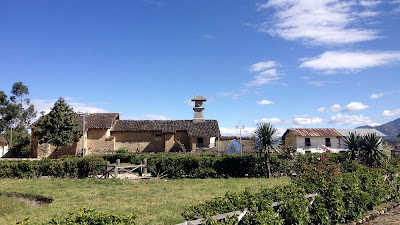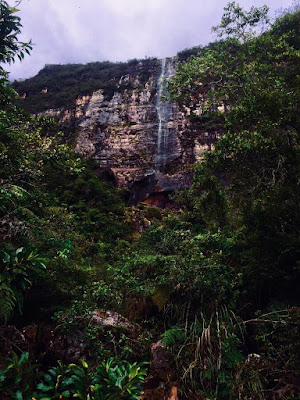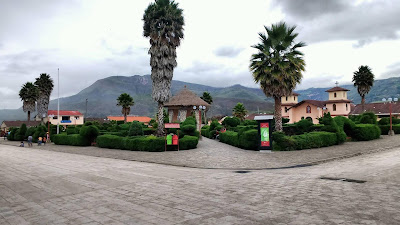Levanto es un pueblo pequeño con mucha
historia. Antes de la conquista Inca,
Levanto o
Llauhuantu era un centro poblado importante de los Sachapuyo y durante el gobierno Inca se convirtió en la capital Inca de la region. Los Españoles bajo el liderazgo de Alonso de Alvarado tenían toda intención de hacerlo la sede principal de sus actividades en la zona cuando fundaron la ciudad
San Juan de de la Frontera de los Chachapoyas en este mismo sitio. Por razones políticas y militares tuvieron que abandonar la ciudad pocos años después de su fundación y nunca volvieron a retomar su construcción.
Hoy, Levanto es un pueblo tranquilo y acogedor que se encuentra a 2400msnm a poco distancia (20km) de la capital
Chachapoyas. En su plaza se encuentra una iglesia de la época colonial que esta completamente hecha de piedra y barro. El pueblo destaca con una vista maravillosa sobre todo el valle hasta la montaña de
Kuelap. Al rededor se encuentran una gran cantidad de ruinas impresionantes como la ciudadela de
Yálape, el tambo militar
Yurac Urco, un canal de agua Incaico y mucho más.
 |
| Iglesia de Levanto |
Como llegar?
La manera más simple de llegar a Levanto es tomar un colectivo desde el terminal de buses en
Chachapoyas. Si cuentas con vehículo propio tienes que encontrar la salida a la carretera Chachapoyas-Levanto en Chachapoyas y seguir la carretera hasta el mismo pueblo. Es pista afirmada pero en buen estado y apto también para un auto regular. De todas maneras llegaras de Chachapoyas a Levanto en aprox. 45 minutos.
Ojo! Debido al mejoramiento vial en Chachapoyas, es un poco difícil de encontrar la carretera a Levanto. Entrando a Chachapoyas toma la derecha después de pasar el mercado mayorista y de allí pregunta por donde es la actual salida hacía Levanto!
Otra forma de llegar a Levanto es
a pie por el antiguo Qhapac Ñan (Camino Inca) que sale desde el molino que se encuentra a aprox. 2km de Chachapoyas en la carretera Chachapoyas-Pedro Ruiz. Es un camino con mucho subida y el recorrida te tomara al menos 3 horas!
Que hacer?
El mayor atractivo de Levanto son sus restos arqueológicos que se encuentran a poca distancia del pueblo. Con el auto o caminando puedes llegar a la ciudadela de
Yálape. Este sitio arqueológico que cubre casi 4 hectáreas se encuentra en un loma más arriba del pueblo. Este ubicación le permite una vista libre de todo el valle hasta la montaña de
Kuelap. Estando en Yálape, es fácil de imaginarse que estas dos ciudades se comunicaron usando señales de humo o fuego.
Lamentablemente, gran parte de Yálape está cubierta en vegetación lo cual hace la visita complicada. Los pobladores nos contaron que una vez si se limpió todo el sitio arqueológico pero por falta de responsabilidad y fondos no se mantuvo limpio y la naturaleza retomo su lugar. Ahora, el terreno es puro monte y se recomienda entrar con botas de jebe, machete y un lugareño para orientación.
 |
| Ruinas de Yálape |
 |
| Vista de la montaña de Kuelap |
Otro sitio arqueológico interesante es
Yurac Urco en Colla Cruz, un anexo de Levanto. Esta casa redonda era un tambo militar durante el reino Inca y fue reconstruida en los años 90 por el arqueólogo Deyvis Morgan. Es una casa típica de la cultura chachapoya hecha de piedra con un techo cono de paja.
 |
| Casa redonda de Yurac Urco |
Donde quedarse?
Como Levanto todavía no esta muy desarrollado turísticamente, no hay muchas opciones. La mejor opción nos parece el hospedaje de las casas redondas que se encuentra en la esquina de la plaza al costado de la iglesia. Este bonito lugar tiene dos casas redondas típicas con techo cono de paja. El precio de una noche es de 25 Soles por persona y tiene cuartos para hasta 3 personas.
 |
| Hospedaje Casa Redonda |
Y para comer?
Alrededor de la plaza central encontraras bodegas que venden bebidas y snacks. También hay restaurantes que sirven comida típica de la zona y menu.
Para más información sobre Levanto y otras actividades en la zona déjanos un comentario o comunícate con nosotros en Facebook: Destino Amazonas
Levanto is small village with lots of
history. Before the Incan conquest,
Levanto or
Llauhuantu was a major settlement of the Chachapoya culture and during the Inca Government it became the Inca capital of the region. The Spanish Conquistadores under leadership of Alonso de Alvarado had every intention to convert it into their headquarters for all their activities in the region and thus founded the city of
San Juan de la Frontera de los Chachapoyas in the very same spot. Due to political and military influences in other parts of the country, they had to leave the city just a few years after foundation and never returned to rebuild it.
Today, Levanto is quiet village located at 2400m altitude and a short distance (20km) from the capital of
Chachapoyas. In the main square you'll find a colonial church built from stone and clay. The village offers an amazing view over the valley, you can even see the mountain
Kuelap was built on. Near the village there are several impressive ruins like the citadel of
Yálape, the military outpost of
Yurac Urco, an Incan water channel and many more.
 |
| Church of Levanto |
How to get there
The easiest way to get to Levanto is to take a minibus from the bus terminal in
Chachapoyas. If you're traveling by car you can simply drive the road from Chachapoyas to Levanto. It's a gravel road but well maintained and drivable for a regular car also. Either way, you'll reach Levanto in about 45 minutes.
Attention! Due to road works in Chachapoyas it is currently a bit difficult to find the road that leads to Levanto. Right after entering Chachapoyas and passing a big market, turn right and ask for directions!
Another way to reach Levanto is
on foot using the old Qhapac Ñan (Inca Trail) that leaves from the mill ("Molino") on the Chachapoyas-Pedro Ruiz highway about 2km from Chachapoyas. It's a path with a long uphill climb and it'll take you at least 3 hours!
What to do
The major attraction of Levanto are it's archeological ruins located near the village. By car or on foot you can visit the citadel of
Yálape. This archeological site is located on a hill above the village and covers over 4 hectares. This location allows for an unobstructed view of the whole valley and even of the mountain on which
Kuelap was built. Once in Yálape, you'll find it easy to imagine that these two communities used smoke and fire signals to communicate with each other.
Sadly, a great part of Yálape is covered with vegetation which makes the visit a bit complicated. The villagers told us that the whole site was cleaned from plants but lack of responsibility and funds there was and is no maintenance of the ruins and nature has since reclaimed it's territory. It is difficult to access the ruins and therefore we recommend bringing boots, a machete and a local guide for direction.
 |
| Ruins of Yálape |
 |
| View of Kuelap |
Another interesting archeological site is
Yurac Urco in Colla Cruz, a hamlet of Levanto. This round house was a military outpost during the Inca rule and was reconstructed in the 90ies by Deyvis Morgan, an archeologist. It's a typical round house of the Chachapoya culture made from stones with a cone shaped thatched roof.
 |
| Round house of Yurac Urco |
Where to stay
Tourism in Levanto is still very slow and there aren't many lodging options. The best place we found were the two round houses located in a corner of the main square right next to the church. This beautiful place features two typical cone shaped houses with thatched roofs. A bed will cost you 25 Soles per night and there are rooms that fit up to three people.
 |
| Hospedaje Casa Redonda |
Where to eat
There are several small shops around the plaza where you can buy drinks and snacks. There are also a few restaurants that serve the usual regional dishes.
For more information about Levanto and the activities in the area contact us on Facebook: Destino Amazonas









Comments
Post a Comment
Tienes una pregunta o quieres dejarnos una sugerencia? Aquí te responderemos!